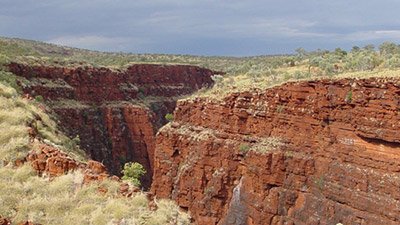Slow Deposition vs. Rapid Flow
PhysOrg: “As Waters Clear, Scientists Seek to End a Muddy Debate” A longstanding understanding of how the “sedimentary geological record” was formed is apparently in error, according to research by geologists at Indiana University–Bloomington and the Massachusetts Institute of Technology.
The research, which appears in this week’s edition of Science, counters the old view of geologists that mud only settles when water is placid, instead showing that “muds will accumulate even when currents move swiftly.”
Explaining the paleontological import of the study, team leader Juergen Schieber, a geologist at Indiana University, said, “Mudstones make up two-thirds of the sedimentary geological record. One thing we are very certain of is that our findings will influence how geologists and paleontologists reconstruct Earth’s past.” Schieber went on to say that geologists have misinterpreted mudstones in the past as indicative of “quiet water deposits” and cited post-flood mud ripples on the university’s campus in his example of how mudstones can form even in turbid water. The team tried to replicate the results under controlled conditions, designing a “mud flume” to simulate “mud deposition in natural flows.”
“Muds will accumulate even when currents move swiftly.”
Schieber’s team chose fine clays for the experiment—calcium montmorillonite and kaolinite, clays that would not settle easily in rapidly moving water, according to the prevailing view. However, the mud flume experiments on both the fine clays and natural lake muds showed that, according to Schieber, “mud beds accumulate at flow velocities that are much higher than what [geologists, until now] would have expected.”
What is most interesting for students of the age of the earth (and the geological and fossil record) is how this research potentially overturns the previous view on mudstone deposition, erosion, and re-deposition, as the press release outlines:
The finding feels like something of a vindication, Schieber says. He and his colleagues have (genially) argued about whether muds could deposit from rapidly flowing water. Schieber had posited the possibility after noting an apparent oddity in the sedimentary rock record.
“In many ancient mudstones, you see not only deposition, but also erosion and rapid re-deposition of mud—all in the same place,” Schieber said. “The erosive features are at odds with the notion that the waters must have been still all or most of the time. We needed a better explanation.”
In other words, this is another example of the uniformitarian view—a little water, a long time—giving way to the possibility that geological landscapes were formed by massive amounts of turbulent water over a short period of time and, once again, pointing out that there should be room to question the existing model.
Remember, if you see a news story that might merit some attention, let us know about it! (Note: if the story originates from the Associated Press, Fox News, MSNBC, the New York Times, or another major national media outlet, we will most likely have already heard about it.) And thanks to all of our readers who have submitted great news tips to us.
(Please note that links will take you directly to the source. Answers in Genesis is not responsible for content on the websites to which we refer. For more information, please see our Privacy Policy.)
Recommended Resources

Answers in Genesis is an apologetics ministry, dedicated to helping Christians defend their faith and proclaim the good news of Jesus Christ.
- Customer Service 800.778.3390
- © 2024 Answers in Genesis






